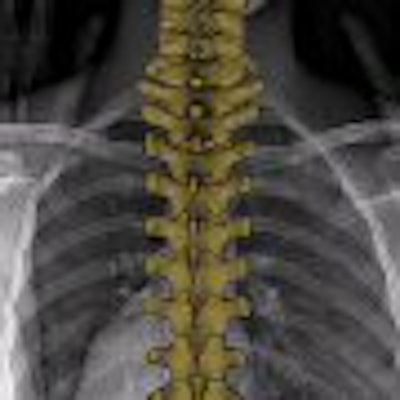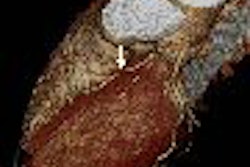
One of the more intriguing new products on display at last month's RSNA meeting in Chicago looked more like a department store dressing room than a piece of advanced medical hardware. But the system, EOS from French biotech firm Biospace Med, represents a radical new design in digital radiography instrumentation that could carve out a niche when it becomes available in mid-2007.
The vast majority of radiography systems currently on the market -- both digital and analog -- are based on a fairly conventional design that hasn't changed much in decades: an x-ray tube at one end and a film-screen cassette or detector at the other. Throw in a table if you want, or mount the assembly on a U-arm or chest stand, depending on the application.
EOS has dispensed with this design in favor of a linear-scanning architecture that starts with a pair of x-ray tube and detector assemblies, positioned at 90° right angles much like a dual-head cardiac gamma camera. These assemblies are mounted on vertical rails and slide up and down during an exam, with the patient standing or sitting inside the system at a point where the x-ray beams from both assemblies intersect. A full head-to-toe scan takes 10-20 seconds to complete.
|
Having trouble viewing this clip? Click here to view full-size clip or to change format. |
EOS produces digital x-ray images of patients in weight-bearing positions, which can be useful for orthopedic studies. The system's design also results in extremely low radiation doses for patients, a benefit in pediatric exams. EOS delivers 10 times less radiation than a conventional x-ray study, and a hundred to a thousand times less radiation than a CT exam, according to Marie Meynadier, president and CEO of the Paris company.
 |
| An EOS study, showing 2D and 3D images. Image courtesy of Biospace Med. |
"What is very special with EOS is that it has a very low dose in digital x-ray, as well as very high dynamic range and 16-bit encoding, so we can look at very low absorption and very high absorption areas," she said.
Biospace Med's digital detector technology is based on work conducted by French physicist Georges Charpak, who won the Nobel Price in physics in 1992 for his work in the development of particle detectors. EOS calls the detector material a microstrip detector, and its use of fan-beam x-ray geometry and high detective quantum efficiency (DQE) contribute to its low dose characteristics.
In addition to images that look like projection x-ray studies, EOS can produce what Biospace Med calls a "3D envelope," basically a surface rendering of the skeletal system. The company believes that the images should prove useful for orthopedic surgeons who want to visualize a 3D presentation of the skeleton in a weight-bearing state.
"We provide (orthopods) with a weight-bearing 3D, which you cannot get from a CT scan, and that weight-bearing 3D image of the skeleton is obtained with just two x-rays," Meynadier said. "We just create a bone envelope, we don't get the 3D information inside the bone. But that envelope is perfectly suited for many, many orthopedic applications, both diagnostic and for therapy planning."
Biospace Med was formed earlier this year as a subsidiary of Biospace, a Paris-based developer of preclinical imaging systems that are sold to pharmaceutical companies, biotech firms, and academic research centers. Biospace has been selling preclinical imaging systems in the U.S. since 2001.
Biospace Med has installed prototype EOS units at hospitals in Montreal, Canada, and France. The company's first noninvestigational unit will be installed at University Hospital in Bordeaux in January 2007. The firm made its RSNA debut at the 2006 show.
When it becomes available, EOS will carry a list price between a high-end DR system and a low-end CT scanner, Meynadier said. The company is planning to file for a CE Mark for European commercialization shortly, with a 510(k) application with the U.S. Food and Drug Administration to follow. Biospace Med hopes to have the system available for the U.S. market in mid-2007.
When the system does become available, Biospace Med hopes that EOS will enable imaging facilities to offer a unique new type of study to referring physicians -- one that has a radiation dose low enough to offer routinely.
"You can turn it into a routine exam -- every time you do 2D, you can get 3D besides the 2D and provide that to the orthopods," Meynadier said.
By Brian Casey
AuntMinnie.com staff writer
December 25, 2006
Related Reading
Road to RSNA, Biospace Med, October 30, 2006
Copyright © 2006 AuntMinnie.com



















